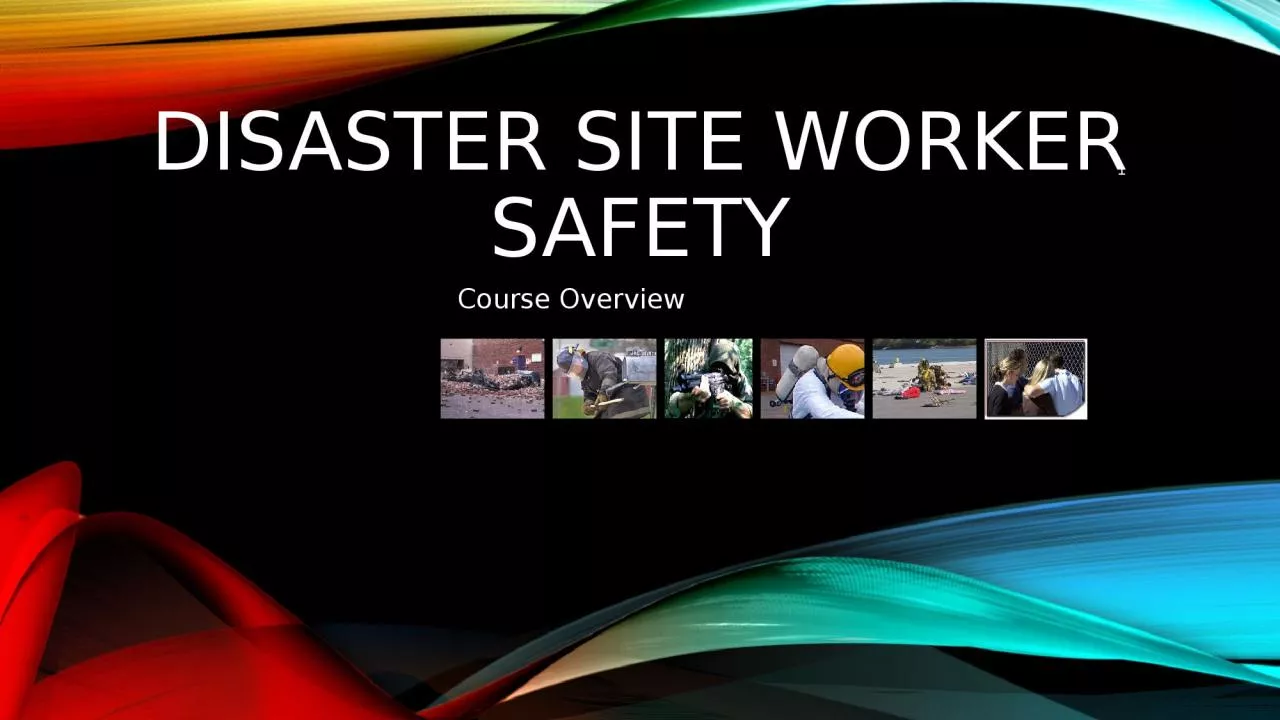

Course Overview 1 Introduction This course Is designed to provide disaster site workers with knowledge information and skills to work safely on disaster sites Encourages participants to recognize and report hazards of assigned job tasks to ensure health and safety for themselves and others ID: 1041988
Download Presentation The PPT/PDF document "Disaster Site Worker Safety" is the property of its rightful owner. Permission is granted to download and print the materials on this web site for personal, non-commercial use only, and to display it on your personal computer provided you do not modify the materials and that you retain all copyright notices contained in the materials. By downloading content from our website, you accept the terms of this agreement.
1. Disaster Site Worker SafetyCourse Overview1
2. IntroductionThis course:Is designed to provide disaster site workers with knowledge, information, and skills to work safely on disaster sites.Encourages participants to recognize and report hazards of assigned job tasks to ensure health and safety for themselves and others.2
3. Expectations of the TrainingOur expectationsAsk questionsShare informationListenYour expectations3
4. What do you get out of this?Knowledge and understanding about the hazards and life safety issues you may encounter at a disaster eventSkill in recognizing hazards and evaluating riskCertificate indicating your attendanceAuthorized OSHA 15-Hour Disaster Site Worker Card4
5. Who Are Disaster Site Workers?Skilled Support Personnel (SSP) — emergency (rescue) and recoveryExamples: Heavy equipment operators; Utility workersGeneral Site Workers — clean-upExamples: Laborers5For the purposes of this training, Disaster Site Workers are:
6. Who Are Disaster Site Workers?Uniformed first respondersFBI agents or other government investigatorsEngineering personnel or other professional service workers6For the purposes of this training, Disaster Site Workers are NOT:
7. Community Disaster SiteAll disasters start (and finish) locally!ConsiderationsMutual aidLocal Emergency Planning CommitteeIndustrial respondersVolunteersWhat do you think your needs would be on a disaster site? (Activity)7
8. TORNADOJoplin, MOSunday – May 22, 20115:34pmEF5 TornadoWinds > 200mph158 Fatalities1,150 InjuriesDamages total $2.8 billionChurch Volunteers working in Joplin, MO
9. FloodingCoastal, TXHurricane HarveyAugust 25th, 2017Category 4130mph winds40 inches of rain69 Fatalities (direct)39 Fatalities (indirect)$125 billion in damagesChurch Volunteers working in flooded homes in coastal areas of Texas.
10. HurricaneKaty, TXHurricane HarveyAugust 25th, 2017Category 4130mph winds40 inches of rain69 Fatalities (direct)39 Fatalities (indirect)$125 billion in damagesContractors Cleaning up after Hurricane Harvey passed through Katy, Texas.
11. Four types of Disasters11
12. Natural Disasters12AvalanchesCoastal ErosionDroughtsEarthquakesWildfiresFloodsLandslidesSevere Local StormsTsunamisVolcanoesExtreme HeatFreezingHailstormsLand Subsidence (cave-ins)Storm SurgesTornadoesHurricanes
13. Technological DisastersDam FailuresFire HazardsEnergy Shortages and Utility OutagesFood and Water Supply ContaminationHazardous Materials ReleasesRadiation HazardsTransportation Accidents13
14. Terrorism14Terrorism ChemicalBiologicalRadiologicalNuclearEnergetic/ExplosiveCyber Attacks
15. Other Disaster PotentialCivil DisorderActive ShooterWorkplace ViolenceCrime ScenesPandemic (an epidemic that is geographically widespread)15
16. Anatomy of a Disaster EventIncreasing Time of Involvement (relative)Increasing Level of Involvement (relative)Initial ResponseCleanup ResponseSkilled Support PersonnelEmergency Response PersonnelCrisis ManagementConsequence ManagementGeneral Site WorkersTransition Response Personnel
17. 17Responder CategoriesEmergency Response PersonnelFirePoliceHazmatEMSSearch and RescueNational GuardUS Coast Guard
18. Responder CategoriesOperating engineersHeavy equipment maintenance workersTruck loaders and driversRiggersTorch cuttersIron workersClean up responseSheet metal workersAsbestos and lead abatement workersDecontamination workers CarpentersLaborersUtility workersSanitation workers18Transition Response Personnel
19. Additional Transition Responders(personnel not part of this training)Structural engineersCoroner/Medical ExaminerAnimal control veterinariansEnvironmental techniciansSafety and health (OSHA and private sector)Surveyors19
20. 20Responder CategoriesClean up response activitiesWorkers involved may include those in the previous slideUsually more is “known” about actual site hazards in the cleanup phase than in the transition phase of a disaster eventGeneral Site Workers
21. ActivityYou are doing your job on a disaster site.List those activities you would consider to be safe.List those activities you would consider unsafe.21
22. Essential KnowledgeHazard Recognition & Assessment.Health Hazards.Safety Hazards.Decontamination Procedures.Understand their function in the Incident Command System (ICS) / Unified Command (UC).Traumatic StressCBRNE22
23. Essential SkillsRecognize hazards or abnormal conditions.Identify safe and appropriate use of Personal Protective Equipment (PPE).Perform proper use, inspection, donning & doffing of respirator.23
24. Employee Rights: Highlights for Disaster SitesRequest information on hazards, precautions, and proceduresGain access to exposure and medical recordsObserve monitoring/measuring of hazardous materials and obtain the resultsReview injury and illness recordsSee also OSHA publication 3021 “OSHA: Employee Workplace Rights”24
25. Employee Responsibilities: Highlights for Disaster SitesWork cooperatively to reduce hazardsFollow safety and health rules and regulationsWear or use prescribed PPEReport hazardous conditionsReport job-related injury/illness & seek treatment promptlySee also OSHA Publication 3021 “OSHA: Employee Workplace Rights”25
26. HAZARDRECOGNITION & ASSESSMENTDashboard